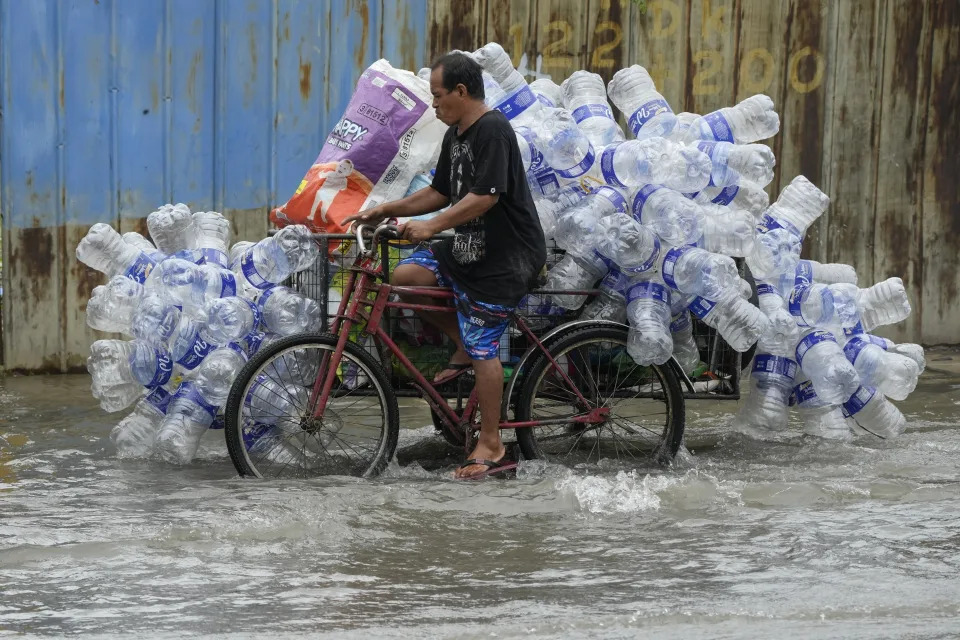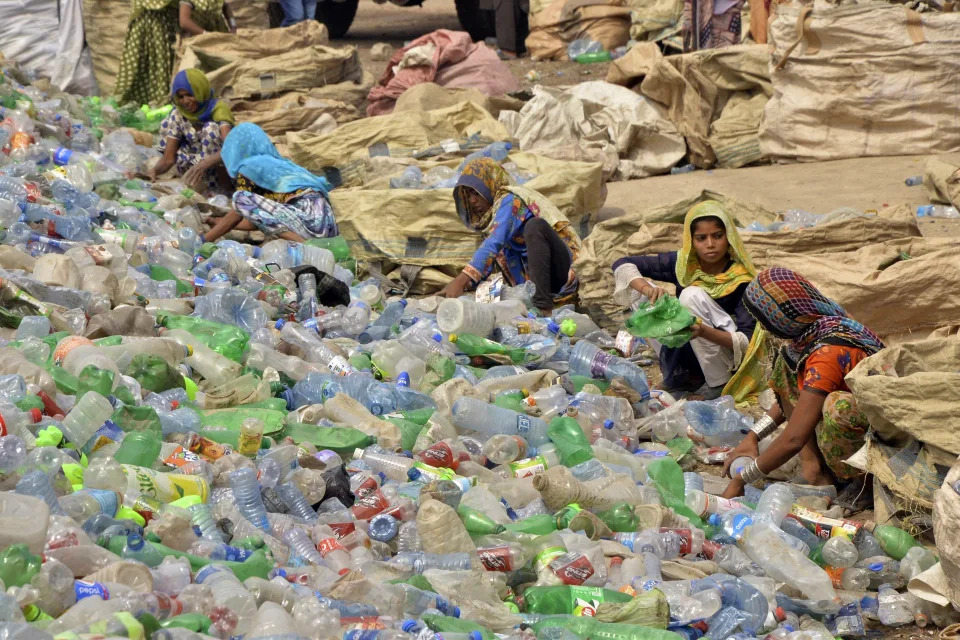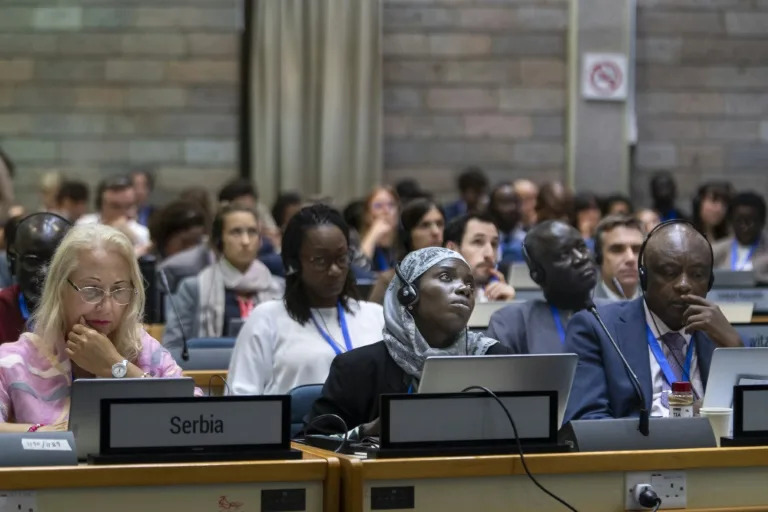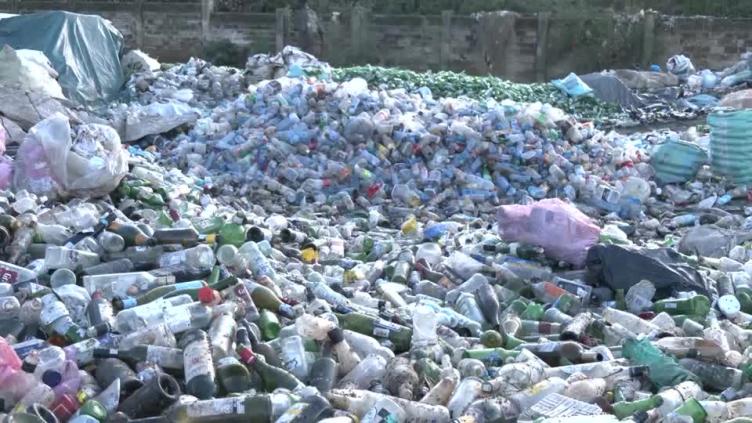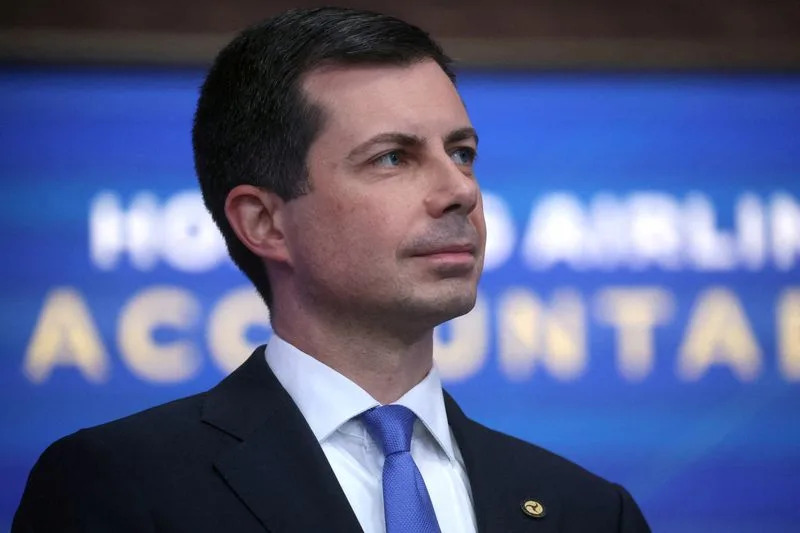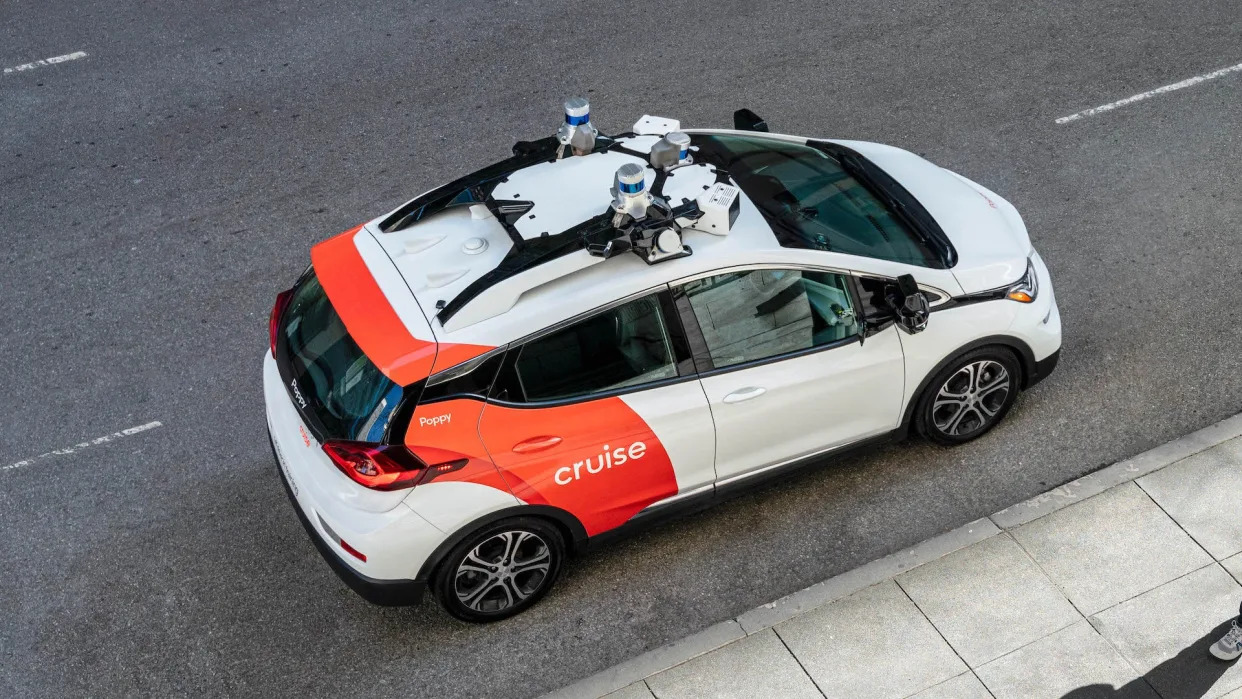Earth is speeding to 2.5 to 2.9 degrees Celsius (4.5 to 5.2 degrees Fahrenheit) of global warming since pre-industrial times, set to blow well past the agreed-upon international climate threshold, a United Nations report calculated.
To have an even money shot at keeping warming to the 1.5-degree Celsius (2.7 degrees Fahrenheit) limit adopted by the 2015 Paris climate agreement, countries have to slash their emissions by 42% by the end of the decade, said the U.N. Environment Programme’s Emissions Gap report issued Monday. Carbon emissions from the burning of coal, oil and gas rose 1.2% last year, the report said.
This year Earth got a taste of what’s to come, said the report, which sets the table for international climate talks later this month.
Through the end of September, the daily global average temperature exceeded 1.5 degrees Celsius above mid-19th century levels on 86 days this year, the report said. But that increased to 127 days because nearly all of the first two weeks of November and all of October reached or exceeded 1.5 degrees, according to the European climate service Copernicus. That's 40% of the days so far this year.
On Friday, the globe hit 2 degrees Celsius (3.6 degrees) above pre-industrial levels for the first time in recorded history, according to Copernicus Deputy Director Samantha Burgess.
“It’s really an indication that we are already seeing a change, an acceleration,” said report lead author Anne Olhoff of Denmark’s climate think tank Concito. “Based on what science tells us, this is just like a whisper. What will be in the future will be more like a roar.”
It's dangerous already, said UNEP Director Inger Andersen.
“Temperatures are hitting new heights, while extreme weather events are occurring more and more often, developing faster and becoming much more intense,” Andersen said. The new report “tells us that it's going to take a massive and urgent shift to avoid these records falling year after year.”
The 1.5-degree goal is based on a time period measured over many years, not days, scientists said. Earlier reports put Earth reaching that longer term limit in early 2029 without dramatic emission changes.
To keep that from happening, the countries of the world have to come up with more stringent goals to cut emissions of carbon dioxide and implement policies to act on those goals, Olhoff said.
In the past two years only nine countries have come up with new goals, so that hasn’t moved the needle, but some countries, including the United States and those in Europe, have put policies in place that slightly improved the outlook, she said.
The United States’ Inflation Reduction Act, which has $375 billion in spending on clean energy, by 2030 would reduce yearly emissions of carbon dioxide by about 1 billion metric tons, Olhoff said.
That sounds like a lot, but the world in 2022 spewed 57.4 billion metric tons of greenhouse gases. Current country pledges would trim that to 55 billion metric tons, and to limit warming to the 1.5 degree mark emissions in 2030 have to be down to 33 billion metric tons. That's an “emissions gap” of 22 billion metric tons.
United Nations Secretary-General Antonio Guterres said “the emissions gap is more like an emissions canyon — a canyon littered with broken promises, broken lives and broken records.”
That’s why the report said the chance of keeping warming at or under 1.5 degrees is about one-in-seven or about 14%, “very, very slim indeed,” Olhoff said.
If the world wants to settle for a warming limit of 2 degrees Celsius — a secondary threshold in the Paris agreement — it only has to trim emissions down to 41 billion metric tons, with a gap of 16 billion metric tons from now, the report said.
Because the world has already warmed nearly 1.2 degrees Celsius (2.2 degrees Fahrenheit) since the mid-19th century, the report’s projections would mean another 1.3 to 1.7 degrees Celsius (2.3 to 3.1 degrees Fahrenheit) warming by the end of this century.
For two years countries have known they have to come up with more ambitious emission cuts targets if the world wants to limit warming to 1.5 degrees, but “none of the large emitters have changed their pledges,” said study co-author Niklas Hohne, a scientist at the New Climate Institute in Germany.
That’s why for the past few years the grim outlook from annual Emissions Gap reports barely changed, Olhoff said.
This year’s emissions gap report is accurate yet not surprising and the projected temperature range fits with other groups’ calculations, said Climate Analytics scientist Bill Hare, who wasn’t part of the report.
Guterres reiterated his call for countries to phase out the use of fossil fuels in time to keep the 1.5 degree limit alive, saying “otherwise we're simply inflating the lifeboats while breaking the oars.”
“We know now that the impacts of climate change, of global warming of somewhere between 2.5 and 3 degrees Celsius are going to be massive,” Olhoff said in an interview. “It’s basically not a future I think anybody would want for their children and grandchildren and so forth. The good news, of course, is that we can act and we know what we have to do.”
___
Read more of AP’s climate coverage at http://www.apnews.com/climate-and-environment.
___
Follow Seth Borenstein on X, formerly known as Twitter, at @borenbears
___
Associated Press climate and environmental coverage receives support from several private foundations. See more about AP’s climate initiative here. The AP is solely responsible for all content.
Climate on track to warm by nearly 3C without aggressive actions, UN report finds
Mon, November 20, 2023
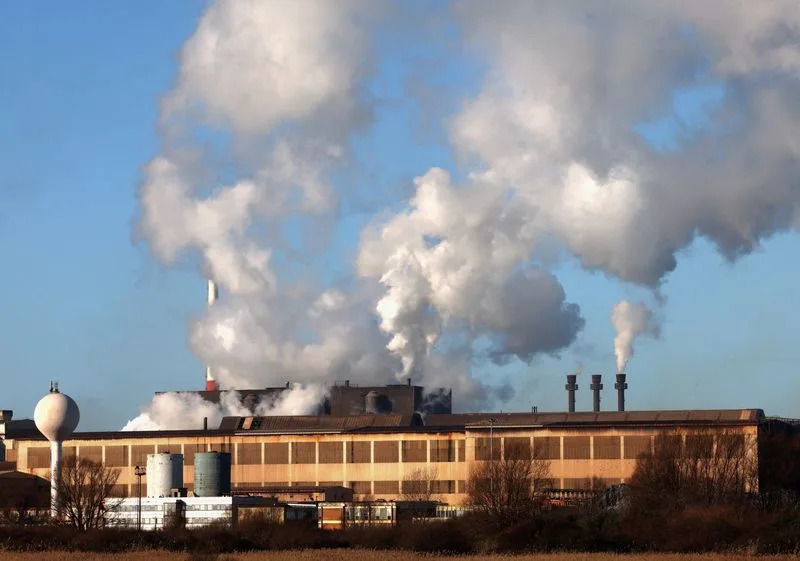
Smoke rises from chimneys at a factory in the port of Dunkirk
By Gloria Dickie
LONDON (Reuters) -Countries' current emissions pledges to limit climate change would still put the world on track to warm by nearly 3 degrees Celsius this century, according to a United Nations analysis released Monday.
The annual Emissions Gap report, which assesses countries' promises to tackle climate change compared with what is needed, finds the world faces between 2.5C (4.5F) and 2.9C (5.2F) of warming above preindustrial levels if governments do not boost climate action.
At 3C of warming, scientists predict the world could pass several catastrophic points of no return, from the runaway melting of ice sheets to the Amazon rainforest drying out.
"Present trends are racing our planet down a dead-end 3C temperature rise," said U.N. Secretary-General Antonio Guterres. "The emissions gap is more like an emissions canyon."
World leaders will soon meet in Dubai for the annual U.N. climate summit COP28 with the aim of keeping the Paris Agreement warming target of 1.5C alive.
But the new U.N. report does little to inspire hope that this goal remains in reach, finding that planet-warming greenhouse gas emissions must fall by 42% by 2030 to hold warming at 1.5C (2.7F).
Even in the most optimistic emissions scenario, the chance of now limiting warming to 1.5C is just 14% — adding to a growing body of scientific evidence suggesting the goal is dead.
Global greenhouse gas emissions rose by 1.2% from 2021 to 2022, reaching a record 57.4 gigatonnes of carbon dioxide equivalent.
The report assessed countries' Nationally Determined Contributions (NDCs), which they are required to update every five years, to determine how much the world might warm if these plans were fully implemented.
It compares unconditional pledges — promises with no strings attached, which would lead to a 2.9C temperature rise — to conditional pledges that would hold warming to 2.5C.
"That is basically unchanged compared with last year's report," said Anne Olhoff, chief scientific editor of the report.
The anticipated level of warming is slightly higher than 2022 projections, which then pointed toward a rise of between 2.4C and 2.6C by 2100, because the 2023 report ran simulations on more climate models.
However, the world has made progress since the Paris Agreement was adopted in 2015. Warming projections based on emissions at that time "were way higher than they are now", Olhoff said.
(Reporting by Gloria Dickie; Editing by Jan Harvey)
UN: World on track to double warming limit this century
Zack Budryk
THE HILL
Mon, November 20, 2023
The world is on track to reach nearly 3 degrees Celsius of warming this century, double the United Nations’s threshold, even if developed nations meet their current emissions pledges, according to a report the U.N. issued Monday.
In its annual Emissions Gap report, the U.N. Environment Program (UNEP) projected that by the end of the century, the world will warm by up to 2.9 degrees Celsius from preindustrial levels absent further action. UNEP estimated that fully implementing all of the Paris Climate Agreement’s unconditional nationally determined contributions (NDCs) would put the globe on track to warm by 2.9 degrees this century, while implementing the conditional NDCs would result in a 2.5-degree increase.
The U.N. identified some progress on emissions. In 2015, the year of the Paris Climate Agreement, the world was on track to up greenhouse gas emissions by 16 percent by 2030. The new report indicates that figure is down to 3 percent.
The report projects that to limit warming to the 1.5-degree threshold, greenhouse gas emissions must be cut by at least 42 percent by the end of the decade. Emissions must fall 28 percent to stay within the 2-degree limit of the Paris Agreement.
“Present trends are racing our planet down a dead-end three-degree temperature rise. In short, the report shows that the emissions gap is more like an emissions canyon. A canyon littered with broken promises, broken lives, and broken records,” U.N. Secretary-General Antonio Guterres said in a Monday press conference. ”All of this is a failure of leadership, a betrayal of the vulnerable, and a massive missed opportunity. Renewables have never been cheaper or more accessible.”
The report comes as nations are set to convene in Dubai for the COP28 climate conference at the end of November. It also follows the warmest summer on record, followed by a similarly record-breaking September that climatologists say is likely to presage the warmest overall year on record.
Climate on track to warm by nearly 3C - UN report
Reuters Videos
Mon, November 20, 2023
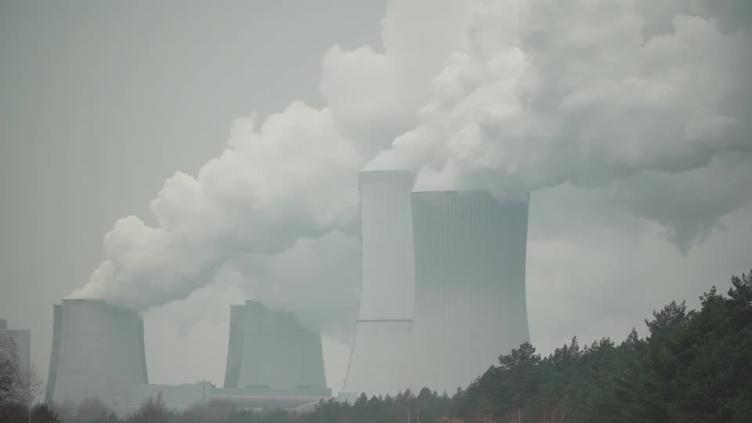
STORY: (U.N. Secretary-General Antonio Guterres) "Present trends are racing our planet down a dead-end 3C temperature rise."
The world is on track to warm by nearly 3 degrees Celsius this century.
That's according to a new United Nations analysis, released ahead of the COP28 climate summit in the United Arab Emirates.
U.N. Secretary-General Antonio Guterres:
"The report shows that the emissions gap is more like an emissions canyon."
The annual Emissions Gap report assesses countries' promises to tackle climate change compared with what is needed.
Anne Olhoff is the Chief Scientific Editor of this report:
"Based on what countries are doing right now, if they continue with the current efforts of climate mitigation, then we're looking at limiting temperature increase to three degrees throughout the century. With the climate promises for 2030, we're looking at an increase of between 2.5 and 2.9 degrees Celsius. So that's a massive global warming and a lot, way beyond the Paris Agreement."
At 3 degrees Celsius of warming, scientists predict the world could pass several catastrophic points of no return, from the runaway melting of ice sheets to the Amazon rainforest drying out.
“We will see maybe ten times as many extreme weather events in terms of extreme temperatures. We will see more heavy precipitation and of course, lots of damages following such as wildfires and so forth."
World leaders will soon meet in Dubai for the COP28 summit with the aim of keeping the Paris Agreement warming target of 1.5 degree Celsius alive.
But the new U.N. report does little to inspire hope that this goal remains in reach.
It found that greenhouse gas emissions must fall by 42% by 2030 to hold warming at 1.5C.
But global emissions actually rose by more than 1% between 2021 and 2022, reaching a record 57.4 gigatonnes of carbon dioxide equivalent.
(Antonio Guterres) "We must reverse course. And as we have seen in this report, the crucial aspect is the addiction to fossil fuels. So it's time to establish a clear phase down with a time limit linked to the 1.5 degrees and it's time to be determined in pursuing that phase down policy. And I hope governments will understand it, and I hope that there will be a clear signal from the COP that we must move in that direction."
Earth to warm up to 2.9C even with current climate pledges: UN
Kelly Macnamara and Julien Mivielle
Mon, November 20, 2023
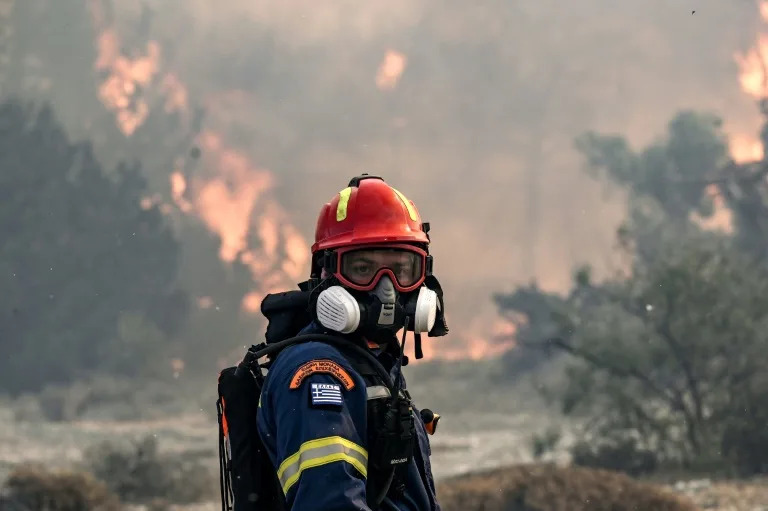
2023 is expected to be the hottest year in human history (Spyros BAKALIS)
Countries' greenhouse gas-cutting pledges put Earth on track for warming far beyond key limits, potentially up to a catastrophic 2.9 degrees Celsius this century, the UN said Monday, warning "we are out of road".
The UN Environment Programme's annual Emissions Gap report is released just ahead of crucial COP28 climate talks in Dubai and will feed into the global response to a sobering official "stocktake" of the failure to curb warming so far.
With this year expected to be the hottest in human history, UNEP said "the world is witnessing a disturbing acceleration in the number, speed and scale of broken climate records".
Taking into account countries' carbon-cutting plans, UNEP warned that the planet is on a path for disastrous heating of between 2.5C and 2.9C by 2100. Based just on existing policies and emissions-cutting efforts, global warming would reach 3C.
But the world continues to pump record levels of greenhouse gases into the atmosphere, with emissions up 1.2 percent from 2021 to 2022, UNEP said, adding that the increase was largely driven by the burning of fossil fuels and industrial processes.
UN Secretary-General Antonio Guterres called for the COP28 talks, which begin on November 30, to outline "dramatic climate action".
"Leaders can't kick the can any further. We're out of road," he said, denouncing a "failure of leadership, a betrayal of the vulnerable, and a massive missed opportunity".
He said the world "must reverse course" and called for a clear signal at the COP28 meeting that the world was preparing for a decisive move away from polluting coal, oil and gas.
- 'Snooze mode' -
The 2015 Paris Agreement saw countries agree to cap global warming at "well below" 2C above preindustrial times -- with a safer limit of 1.5C if possible.
Nearly 1.2C of global heating so far has already unleashed an escalating barrage of deadly impacts across the planet.
UNEP said temperatures have gone above 1.5C for more than 80 days already this year, although the Paris warming thresholds will be measured as an average over several decades.
The Emissions Gap report looks at the difference between the planet-heating pollution that will still be released under countries' decarbonisation plans and what science says is needed to keep to the goals of the Paris Agreement.
By 2030, UNEP said, global emissions will have to be 28 percent lower than current policies would suggest in order to stay below 2C, and 42 percent lower for the more ambitious limit of 1.5C.
UNEP chief Inger Andersen said it was crucial that G20 nations -- the world's wealthiest economies responsible for around 80 percent of emissions -- "step up" and lead on reductions, but noted some were in "snooze mode".
- 'Climate won't wait' -
Under the Paris deal, countries are required to submit ever deeper emission cutting plans, known as Nationally Determined Contributions (NDCs).
UNEP found that fully implementing "unconditional" NDCs for 2030 -- which countries plan regardless of external support -- would give a 66 percent likelihood of Earth's average temperature rising by 2.9C by 2100.
Scientists warn that warming of these levels could render vast swathes of the planet essentially uninhabitable for humans and risk irreversible tipping points on land and in the oceans.
Conditional NDCs -- which rely on international funding to achieve -- would probably lower this to a still catastrophic 2.5C temperature rise this century, it said.
UNEP said that if all conditional NDCs and longer-term net zero pledges were met in their entirety it would be possible to limit temperature rise to 2C.
But it cautioned that currently these net zero pledges were not considered credible, with none of the G20 nations reducing emissions in line with their own targets.
Even in the most optimistic scenario, the chance of limiting temperature rise to 1.5C is just 14 percent, UNEP said.
Guterres called for "an explosion of ambition" regarding countries setting their NDCs -- which are due to be updated by 2025.
Andersen said she is optimistic that countries will be able to make progress at the November 30 to December 12 COP28, despite the fractures caused by Russia's invasion of Ukraine and the conflict between Israel and Hamas.
"Countries and delegations understand that, irrespective of these deep divisions that do exist and that are undeniable, the environment doesn't wait and climate most certainly will not," she said.
"You can't press the pause button."
klm-jmi/acc
World on track for nearly 3C of warming under current climate plans, UN report warns
Rosie Frost
Mon, November 20, 2023
A new report from the UN Environment Programme (UNEP), released over a week before climate summit COP28 begins in Dubai, says urgent action is needed to prevent this projection from becoming a reality.
Global greenhouse gasses must be cut by 28 per cent to keep within 2C and 42 per cent to keep the 1.5C limit alive. To do this, mitigation efforts must be significantly strengthened this decade.
“Today's Emissions Gap report shows that if nothing changes, in 2030 emissions will be 22 Gigatonnes higher than the 1.5 degree-limit will allow,” UN secretary-general Antonio Guterres said.
“That's roughly the total present annual emissions of the USA, China, and the EU combined.”
Paris, Münster, Milan: Which European cities are doing the most for climate change?
Floods, droughts and panic attacks: Climate change is taking its toll on Europe's farmers
2023 has been a record-breaking year
Global greenhouse gas emissions are reaching all time highs after a 1.2 per cent increase last year, according to the UNEP.
These record emissions are causing record temperatures.
Up until the start of October, average temperatures more than 1.5C above pre-industrial levels were recorded on 86 days.
September was the hottest month on record with average global temperatures reaching 1.8C above pre-industrial levels.
And average global temperatures likely crossed over the critical threshold of 2C above pre-industrial levels last week, according to the EU’s Copernicus Climate Change Service.
These average temperatures need to be sustained over a longer period of time in order to breach official limits such as those set in the Paris Agreement, however.
“This year we’ve seen a horrendous number of records and extremes in terms of heat, in terms of wildfires and in terms of setting new global temperature records,” Anne Olhoff, chief scientific editor of the report, tells Euronews Green.
“But all of what we are seeing now will be like a whisper when what we’ll see in the future will be a roar.”

Residents of a riverside community in Amazonas state carry food and containers of drinking water distributed due to drought and high temperatures. - AP Photo /Edmar Barros
Has the Paris Agreement made a difference to emissions?
There has been progress since the Paris Agreement in 2015. Under policies in place then, the UNEP predicted a 16 per cent increase in emissions by 2030. Now the projected increase is 3 per cent.
“I do think that we have seen progress, I'm not saying nothing has happened,” Olhoff says.
“But it's really now or never in terms of at least keeping the window for limiting global warming to 1.5 degrees alive at all.”
Big opportunities to cut emissions have been lost in the last few years, she adds. While the war in Ukraine and the resulting energy crisis pushed some countries towards green solutions, others used it to open up new oil and gas exploration or extend the life of coal mines.
One of the biggest obstacles to closing the emissions gap, Olhoff says, is “a lack of global leadership”.
Lobbying undermines climate pledges of more than half the world's top companies, report reveals
COP28: Climate action ‘supernova’ needed to keep Paris Agreement on track, UN warns
A lack of global leadership
If mitigation efforts under current policies continue as they are today, global warming will only be limited to 3C above pre-industrial levels. Fully implementing efforts laid out in countries' climate plans or National Determined Contributions (NDCs) puts the world on track for 2.9C.
None of the 20 biggest economies in the world are cutting emissions at a rate consistent with their net-zero targets. Even under the most optimistic scenario, the UNEP says, the likelihood of limiting warming to 1.5C is only 14 per cent.
The report shows the emissions gap is “more like an emissions canyon”, Guterres added.
“A canyon littered with broken promises, broken lives, and broken records.
“All of this is a failing of leadership, a betrayal of the vulnerable and a massive missed opportunity.”
Rather than focusing solely on stronger targets for 2035, Olhoff says more ambitious action to bring down emissions is needed before the end of the decade.
“First of all, if we don't do that, then we can wave goodbye to 1.5 degrees.”
We’re not yet seeing a peak in emissions and current climate policies show more like a plateau. But there are huge opportunities for most countries to significantly reduce emissions from and end subsidies for fossil fuels, for example.
Reaching peak emissions should be the “easy part of the curve”, Olhoff says, cutting the final 10, 20 or even 30 per cent is likely to be a lot harder.
Earth surpasses critical 2-degree warming threshold, European climate officials say
Hayley Smith
Mon, November 20, 2023

Icebergs float near Kvitoya Island in the Arctic Ocean in July. A scientific expedition that month recorded the impacts of global warming on the glacier-covered island. (Anadolu Agency/Getty Images)
For the first time since record keeping began, Earth has surpassed a critical temperature threshold that scientists have long warned could unleash the worst effects of climate change.
On Friday, the planet soared 2.07 degrees Celsius above preindustrial levels, or the 1850 to 1900 average, according to Europe's Copernicus Climate Change Service.
Two degrees Celsius — or 3.6 degree Fahrenheit — is the internationally agreed upon upper limit of warming established by the 2015 Paris climate agreement. The agreement seeks to hold the increase in the global temperature to well below that limit, and preferably below 1.5 degrees Celsius, in recognition that "this would significantly reduce the risks and impacts of climate change."
Copernicus officials shared the finding Monday in a post on X. Deputy director Samantha Burgess said preliminary data also show that the global temperature on Saturday measured 2.06 degrees Celsius above preindustrial levels, indicating that there are "now two November 2023 days" where the temperature exceeded the benchmark.
Scientists have long warned that sustained warming of 1.5 degrees or more will lead to cascading risks for human and planetary systems, including negative impacts on ecosystems, biodiversity, water supplies and food security. Warming land and ocean temperatures are already contributing to sea level rise, melting ice sheets and increased hazards such as heat waves, drought and extreme precipitation, according to the Intergovernmental Panel on Climate Change.
While significant challenges are expected for many regions and systems at 1.5 degrees of warming, "risks would be larger at 2 degrees Celsius of warming and an even greater effort would be needed for adaptation to a temperature increase of that magnitude," the IPCC says.
However, caution is warranted when it comes to a single day's data, said Gavin Schmidt, director of NASA's Goddard Institute for Space Studies. He noted that the terms of the Paris climate agreement are more concerned with sustained, years-long warming at those temperatures.
Read more: With hot October temperatures, this is 'virtually certain' to be the warmest year on record
Surpassing 2 degrees once or twice does not indicate a point of no return, Schmidt said. But the record-setting weekend is noteworthy in the context of larger trends.
"Is the planet warming? Yes," Schmidt said. "Are we going to see days above 2 degrees before we get weeks above 2 degrees, before we get to months, before we get to years? Yes. And is the planet right now going through an exceptional warming spurt? The answer is yes, yes it is. 2023 is proving to be exceptional in both the impacts and in these metrics."
Indeed, Monday's announcement came only weeks after officials warned that 2023 is on track to become Earth's warmest year on record following a record-hot June, July, August, September and October. The latest milestone is noteworthy, but also a reminder that it's not too late to change course, said Zeke Hausfather, a research scientist with Berkeley Earth.
"It's a warning that we're starting to get uncomfortably close," Hausfather said. "Certainly the fact that we were seeing months on end of 1.5 degrees [warming] is a sign that that target is quickly slipping by the wayside, and if we keep being complacent for the next decade, we're going to be in the same place regarding 2 degrees."
The majority of the warming is attributed to greenhouse gas emissions from the burning of fossil fuels, he and other experts say. But this year's strengthening El Niño is also playing a role, as the climate pattern is associated with warmer global temperatures.
Read more: 'Every bit matters': Six key takeaways from the latest U.S. climate report
Researchers have also posited that last year's eruption of the Hunga Tonga-Hunga Ha’apai volcano in the South Pacific may be contributing to extreme warming this year. The eruption shot record amounts of heat-trapping water vapor into the atmosphere.
Additionally, a study published this month by renowned climate scientist James Hansen said a recent change in aerosol shipping regulations could be a contributing factor. The regulations reduced the amount of sulfur allowed in fuels in an effort to improve air quality, but the change may have had an unintended planetary warming effect because the aerosols were reflecting sunlight away from Earth.
Hausfather said the volcano eruption and the change in shipping regulations appear to have played a small role in recent warming trends, but not enough to singularly explain how anomalously hot this year has been. That El Niño arrived so quickly after a rare three consecutive years of La Niña, its cooling counterpart, may have made some of its warming effects show up earlier and stronger than in previous years.
"Scientists don't have all the answers right now," he said. "Were going to be doing a lot of research in the next few years to dig into the exact drivers, but it certainly has been an exceptionally warm year so far — and it's going to be the warmest year on record by a fairly large margin."
Not all hope is lost, however. The Fifth National Climate Change Assessment, released last week by the White House, underscored that every fraction of a degree of warming added or averted will make a difference.
The report "clearly shows that per 10th of a degree of avoided warming, we save, we prevent risk, we prevent suffering," Katharine Hayhoe, one of its authors, told The Times.
The news also comes ahead of COP28, an international climate conference that will begin later this month in Dubai.
"We still have time," Hausfather said, "to avoid the future we got a sneak peek of this past weekend."
This story originally appeared in Los Angeles Times.
World Has 14% Chance of Keeping Warming Below 1.5C in Best Case
John Ainger
Mon, November 20, 2023


(Bloomberg) -- The world only has a tiny chance of keeping global warming below a key threshold that could cause several climate tipping points to be reached, drastically exacerbating the likelihood of extreme weather, according to a new report from the United Nations.
Countries have a 14% chance of keeping global warming below 1.5C even in the most optimistic scenario where all net-zero pledges are met, according to an analysis by the UN’s environment program. Current emissions-cutting plans put the world on course for up-to 2.9C of global warming and that’s assuming nations fulfill their unconditional commitments.
The findings come less than two weeks before the COP28 climate summit in Dubai, which has the key aim of laying out what countries need to do to meet the goals set by the Paris Agreement in 2015, chiefly keeping warming below 2C, and ideally 1.5C. To do so, emissions need to fall by 28% to 42% by the end of the decade, compared with current policy scenarios, according to the UN’s report.
“There is no person or economy left on the planet untouched by climate change,”said Inger Andersen, executive director of UNEP. “So we need to stop setting unwanted records on greenhouse gas emissions, global temperature highs and extreme weather.”
Read More: What Is COP28 and Why Is It Important?
There are fears that the battle to “keep 1.5 alive” may have already been lost and that the most realistic scenario now is that warming will have to rise above the critical threshold before coming back down. The report highlighted that, during the first nine months of the year, 86 days were recorded with temperatures over 1.5C above pre-industrial levels. September was the hottest recorded month ever, with global average temperatures 1.8C above pre-industrial levels, the report said.
While El Niño has played some role, the number of extra-hot days this year is overwhelmingly due to human-made emissions, according to Niklas Höhne, founder of the NewClimate Institute and one of the authors of the report.
“The report shows once again a huge discrepancy between where we want to be and where we are,” he said. “Current temperature increase is 1.2C and we already saw significant damage. If we go to double that, you can imagine that this will be an existential threat.”
“Even a 1.5C world is not safe for a large part of the population,” he added.
A similar report last week estimated that carbon emissions released into the atmosphere will increase by about 9% in 2030, compared with 2010 levels, based on current national pledges submitted ahead of the upcoming COP28 climate summit. It’s a marginal improvement from last year, but still means that by 2030, the world may only have two years left of its carbon budget to keep alive a 50% chance of limiting global warming to 1.5C.
“The stark reality is that the projected emissions from coal, oil and gas extraction are on track to exceed the carbon budget needed to limit warming to 1.5C by over 3.5 times,” said Harjeet Singh, head of global political strategy at Climate Action Network.
Read more: World May Warm 2.8C With Current Climate Policies, UN Says
Greenhouse gas emissions are still rising. UNEP’s report showed that the amount of CO2 in the atmosphere increased by 1.2% in 2022 to reach a new record of 57.4 gigatons. Delaying emissions cuts now raises the need to rely on removal technology in the future, something that has yet to be proven at scale.
Höhne said COP28 must move into “emergency mode” and urged countries to pledge a tripling of renewable capacity, a doubling of energy efficiency and a phase-out of fossil fuels to get back in line with a 1.5-degree goal.
“If we are serious about climate, we need to end the use of fossil fuels,” he said. “That should be crystal clear in a decision at COP28.”
--With assistance from Jennifer A. Dlouhy.
